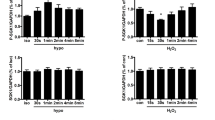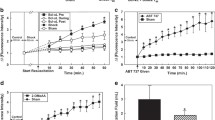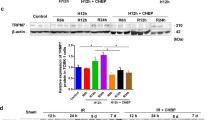Abstract
Cystic fibrosis transmembrane conductance regulator (CFTR) acts as a cAMP-dependent chloride channel, has been studied in various types of cells. CFTR is abundantly expressed in vascular smooth muscle cells and closely linked to vascular tone regulation. However, the functional significance of CFTR in basilar vascular smooth muscle cells (BASMCs) remains elusive. Accumulating evidence has shown the direct role of CFTR in cell apoptosis that contributes to several main pathological events in CF, such as inflammation, lung injury and pancreatic insufficiency. We therefore investigated the role of CFTR in BASMC apoptotic process induced by hydrogen peroxide (H2O2). We found that H2O2-induced cell apoptosis was parallel to a significant decrease in endogenous CFTR protein expression. Silencing CFTR with adenovirus-mediated CFTR specific siRNA further enhanced H2O2-induced BASMC injury, mitochondrial cytochrome c release into cytoplasm, cleaved caspase-3 and -9 protein expression and oxidized glutathione levels; while decreased cell viability, the Bcl-2/Bax ratio, mitochondrial membrane potential, total glutathione levels, activities of superoxide dismutase and catalase. The pharmacological activation of CFTR with forskolin produced the opposite effects. These results strongly suggest that CFTR may modulate oxidative stress-related BASMC apoptosis through the cAMP- and mitochondria-dependent pathway and regulating endogenous antioxidant defense system.







Similar content being viewed by others
References
Cantin A (1995) Cystic fibrosis lung inflammation: early, sustained, and severe. Am J Respir Crit Care Med 151:939–941
Cohen TS, Prince A (2012) Cystic fibrosis: a mucosal immunodeficiency syndrome. Nat Med 18:509–519
Farrell PM, Rosenstein BJ, White TB et al (2008) Guidelines for diagnosis of cystic fibrosis in newborns through older adults: cystic Fibrosis Foundation consensus report. J Pediatr 153:S4–S14
Nichols D, Chmiel J, Berger M (2008) Chronic inflammation in the cystic fibrosis lung: alterations in inter- and intracellular signaling. Clin Rev Allergy Immunol 34:146–162
Robert R, Norez C, Becq F (2005) Disruption of CFTR chloride channel alters mechanical properties and cAMP-dependent Cl- transport of mouse aortic smooth muscle cells. J Physiol 568:483–495
Robert R, Savineau JP, Norez C, Becq F, Guibert C (2007) Expression and function of cystic fibrosis transmembrane conductance regulator in rat intrapulmonary arteries. Eur Respir J 30:857–864
Robert R, Thoreau V, Norez C et al (2004) Regulation of the cystic fibrosis transmembrane conductance regulator channel by beta-adrenergic agonists and vasoactive intestinal peptide in rat smooth muscle cells and its role in vasorelaxation. J Biol Chem 279:21160–21168
Michoud MC, Robert R, Hassan M et al (2009) Role of the cystic fibrosis transmembrane conductance channel in human airway smooth muscle. Am J Respir Cell Mol Biol 40:217–222
Vandebrouck C, Melin P, Norez C et al (2006) Evidence that CFTR is expressed in rat tracheal smooth muscle cells and contributes to bronchodilation. Respir Res 7:113
Zhang YP, Zhang H, Duan DD (2013) Chloride channels in stroke. Acta Pharmacol Sin 34:17–23
Super M, Irtiza-Ali A, Roberts SA et al (2004) Blood pressure and the cystic fibrosis gene: evidence for lower pressure rises with age in female carriers. Hypertension 44:878–883
Lieberman J, Rodbard S (1975) Low blood pressure in young adults with cystic fibrosis: an effect of chronic salt loss in sweat? Ann Intern Med 82:806–808
Maiuri L, Raia V, De Marco G et al (1997) DNA fragmentation is a feature of cystic fibrosis epithelial cells: a disease with inappropriate apoptosis? FEBS Lett 408:225–231
Soleti R, Porro C, Martinez MC (2013) Apoptotic process in cystic fibrosis cells. Apoptosis 18:1029–1038
McKeon DJ, Condliffe AM, Cowburn AS et al (2008) Prolonged survival of neutrophils from patients with Delta F508 CFTR mutations. Thorax 63:660–661
Moriceau S, Kantari C, Mocek J et al (2009) Coronin-1 is associated with neutrophil survival and is cleaved during apoptosis: potential implication in neutrophils from cystic fibrosis patients. J Immunol 182:7254–7263
Rottner M, Kunzelmann C, Mergey M, Freyssinet JM, Martinez MC (2007) Exaggerated apoptosis and NF-kappaB activation in pancreatic and tracheal cystic fibrosis cells. FASEB J 21:2939–2948
Bodas M, Min T, Vij N (2011) Critical role of CFTR-dependent lipid rafts in cigarette smoke-induced lung epithelial injury. Am J Physiol Lung Cell Mol Physiol 300:L811–L820
Xu Y, Krause A, Hamai H, Harvey BG, Worgall TS, Worgall S (2010) Proinflammatory phenotype and increased caveolin-1 in alveolar macrophages with silenced CFTR mRNA. PLoS One 5:e11004
Valdivieso AG, Santa-Coloma TA (2013) CFTR activity and mitochondrial function. Redox Biol 1:190–202
Jendrossek V, Grassme H, Mueller I, Lang F, Gulbins E (2001) Pseudomonas aeruginosa-induced apoptosis involves mitochondria and stress-activated protein kinases. Infect Immun 69:2675–2683
Jiang L, Liu Y, Ma MM, Tang YB, Zhou JG, Guan YY (2013) Mitochondria dependent pathway is involved in the protective effect of bestrophin-3 on hydrogen peroxide-induced apoptosis in basilar artery smooth muscle cells. Apoptosis 18:556–565
Li SY, Wang XG, Ma MM et al (2012) Ginsenoside-Rd potentiates apoptosis induced by hydrogen peroxide in basilar artery smooth muscle cells through the mitochondrial pathway. Apoptosis 17:113–120
Qian Y, Du YH, Tang YB et al (2011) ClC-3 chloride channel prevents apoptosis induced by hydrogen peroxide in basilar artery smooth muscle cells through mitochondria dependent pathway. Apoptosis 16:468–477
Wang M, Yang H, Zheng LY et al (2012) Downregulation of TMEM16A calcium-activated chloride channel contributes to cerebrovascular remodeling during hypertension by promoting basilar smooth muscle cell proliferation. Circulation 125:697–707
Liu YJ, Wang XG, Tang YB et al (2010) Simvastatin ameliorates rat cerebrovascular remodeling during hypertension via inhibition of volume-regulated chloride channel. Hypertension 56:445–452
Tang YB, Liu YJ, Zhou JG, Wang GL, Qiu QY, Guan YY (2008) Silence of ClC-3 chloride channel inhibits cell proliferation and the cell cycle via G/S phase arrest in rat basilar arterial smooth muscle cells. Cell Prolif 41:775–785
Wang GL, Wang XR, Lin MJ, He H, Lan XJ, Guan YY (2002) Deficiency in ClC-3 chloride channels prevents rat aortic smooth muscle cell proliferation. Circ Res 91:E28–E32
Guo JJ, Stoltz DA, Zhu V et al (2013) Genotype-specific alterations in vascular smooth muscle cell function in cystic fibrosis piglets. J Cyst Fibros 13:251–259
Meissner A, Yang J, Kroetsch JT et al (2012) Tumor necrosis factor-alpha-mediated downregulation of the cystic fibrosis transmembrane conductance regulator drives pathological sphingosine-1-phosphate signaling in a mouse model of heart failure. Circulation 125:2739–2750
l’Hoste S, Chargui A, Belfodil R et al (2010) CFTR mediates apoptotic volume decrease and cell death by controlling glutathione efflux and ROS production in cultured mice proximal tubules. Am J Physiol Renal Physiol 298:F435–F453
Moriceau S, Lenoir G, Witko-Sarsat V (2010) In cystic fibrosis homozygotes and heterozygotes, neutrophil apoptosis is delayed and modulated by diamide or roscovitine: evidence for an innate neutrophil disturbance. J Innate Immun 2:260–266
Olivier AK, Yi Y, Sun X et al (2012) Abnormal endocrine pancreas function at birth in cystic fibrosis ferrets. J Clin Invest 122:3755–3768
Xiang SY, Ye LL, Duan LL et al (2011) Characterization of a critical role for CFTR chloride channels in cardioprotection against ischemia/reperfusion injury. Acta Pharmacol Sin 32:824–833
Chaudhary N, Datta K, Askin FB, Staab JF, Marr KA (2012) Cystic fibrosis transmembrane conductance regulator regulates epithelial cell response to Aspergillus and resultant pulmonary inflammation. Am J Respir Crit Care Med 185:301–310
L’Hoste S, Chargui A, Belfodil R et al (2009) CFTR mediates cadmium-induced apoptosis through modulation of ROS level in mouse proximal tubule cells. Free Radic Biol Med 46:1017–1031
Velsor LW, Kariya C, Kachadourian R, Day BJ (2006) Mitochondrial oxidative stress in the lungs of cystic fibrosis transmembrane conductance regulator protein mutant mice. Am J Respir Cell Mol Biol 35:579–586
Chen J, Kinter M, Shank S, Cotton C, Kelley TJ, Ziady AG (2008) Dysfunction of Nrf-2 in CF epithelia leads to excess intracellular H2O2 and inflammatory cytokine production. PLoS One 3:e3367
Rottner M, Tual-Chalot S, Mostefai HA, Andriantsitohaina R, Freyssinet JM, Martinez MC (2011) Increased oxidative stress induces apoptosis in human cystic fibrosis cells. PLoS One 6:e24880
Luoma JS, Stralin P, Marklund SL, Hiltunen TP, Sarkioja T, Yla-Herttuala S (1998) Expression of extracellular SOD and iNOS in macrophages and smooth muscle cells in human and rabbit atherosclerotic lesions: colocalization with epitopes characteristic of oxidized LDL and peroxynitrite-modified proteins. Arterioscler Thromb Vasc Biol 18:157–167
Shapiro BL (1989) Evidence for a mitochondrial lesion in cystic fibrosis. Life Sci 44:1327–1334
Shapiro BL (1988) Mitochondrial dysfunction, energy expenditure, and cystic fibrosis. Lancet 2:289
Valdivieso AG, Clauzure M, Marin MC et al (2012) The mitochondrial complex I activity is reduced in cells with impaired cystic fibrosis transmembrane conductance regulator (CFTR) function. PLoS One 7:e48059
Chipperfield AR, Harper AA (2000) Chloride in smooth muscle. Prog Biophys Mol Biol 74:175–221
Bulley S, Jaggar JH (2013) Cl channels in smooth muscle cells. Pflugers Arch 466:873
Duan D (2009) Phenomics of cardiac chloride channels: the systematic study of chloride channel function in the heart. J Physiol 587:2163–2177
Guan YY, Wang GL, Zhou JG (2006) The ClC-3 Cl- channel in cell volume regulation, proliferation and apoptosis in vascular smooth muscle cells. Trends Pharmacol Sci 27:290–296
Shi XL, Wang GL, Zhang Z et al (2007) Alteration of volume-regulated chloride movement in rat cerebrovascular smooth muscle cells during hypertension. Hypertension 49:1371–1377
Zheng LY, Li L, Ma MM et al (2013) Deficiency of volume-regulated ClC-3 chloride channel attenuates cerebrovascular remodelling in DOCA-salt hypertension. Cardiovasc Res 100:134–142
Acknowledgments
This study was supported by National Natural Science Foundation of China (Key Grants Nos. 81230082, and 81370897, 81173055) and NSFC-CIHR, CHINA-CANADA Joint Health Research Initiative Proposal (No. 813111115).
Author information
Authors and Affiliations
Corresponding authors
Additional information
Jia-Wei Zeng, Xue-Lin Zeng, Fei-Ya Li they equally contribute to this work
Rights and permissions
About this article
Cite this article
Zeng, JW., Zeng, XL., Li, FY. et al. Cystic Fibrosis Transmembrane Conductance Regulator (CFTR) prevents apoptosis induced by hydrogen peroxide in basilar artery smooth muscle cells. Apoptosis 19, 1317–1329 (2014). https://doi.org/10.1007/s10495-014-1014-z
Published:
Issue Date:
DOI: https://doi.org/10.1007/s10495-014-1014-z




